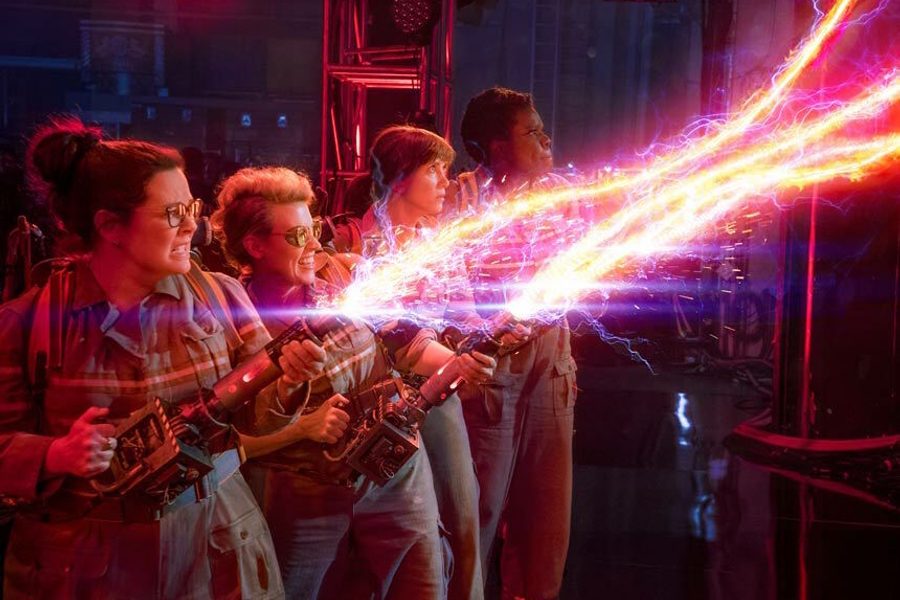Ghostbusters Is a Classic Summer Escape Film—But From Misogyny
Your ticket buys a joyful romp and a 1-hour, 45-minute break from sexism
Jude Ellison Sady Doyle

Here is the most important thing to know about Ghostbusters, the notoriously female-led reboot of the 1984 film: It is a fun little movie. It is a tiny, imperfect, warm-hearted slice of joy; a diversion, a way to slip into an air-conditioned theater during a brutal and depressing summer and feel (for a few hours, anyway) that something easy and fun exists in the world.
I saw Ghostbusters in a movie theater so technologically advanced that I wasn’t even aware that anything like it existed — not only did you get the by-now-standard 3-D glasses, the seats were on motors, and would vibrate and tilt around like a theme-park ride during key moments of the movie. (A lot has been said about the female-solidarity potential of an all-lady cast, but I have to admit that having an actual vibrator built into the seat was a level of female solidarity that even I felt a little uncomfortable with.) I think, though I’m not sure, that there was some kind of built-in air conditioning that allowed breezes to blow past you during the car chase scenes. This is all relevant, because it is that exact level of day-at-the-carnival stupid fun which Ghostbusters aims to provide its audience. This movie is an object made for the express purpose of permitting its audience members to stop thinking too deeply about anything in particular and simply enjoy themselves.
It is important that I get this out of the way now. Because, the moment I got home from Ghostbusters, I got word that one of its stars, Leslie Jones, was being deluged on Twitter with racist threats and rape threats so vile that I couldn’t even look at them without getting sick. There were hundreds. There were cartoons of child porn. There was a picture of Jones Photoshopped so that it looked like semen was on her face. There was someone typing the word “coon” at her over and over and over again, and there were Photoshopped Tweets of her saying vile things, and there were people calling her a monkey or a gorilla, and there were simply some people calling her the n-word, and this. Went. On. For. Hours. Jones eventually left Twitter (permanently or not, there’s no way to know). One of the ringleaders of her assault, the infamous Milo Yiannopolous, has been banned from the site. But nothing can undo the damage.
All of this, for what? For nothing. For a theme park ride. For the choice of this particular black woman to take a job, in a movie, so that we could feel a few hours of uncomplicated joy.
She does a great job, by the way. Leslie Jones is just wonderful in that movie. All of the cast members are. I think I would have enjoyed Ghostbusters, even if my seat didn’t vibrate, and I think you most likely would too.
At some point in the film, a plot unfolds, though it’s so simple it hardly bears repeating. Erin (Kristen Wiig) has given up on believing in ghosts because she wants to be taken seriously as a scientist, childhood friend Abby (Melissa McCarthy) still believes in them, it turns out that ghosts exist — I sincerely hope you were not waiting for this reveal, because there is not a lot of mystery on the whole “are there ghosts” question in Ghostbusters — so they team up with a mad scientist (Kate McKinnon) and a New York history buff (Jones) and proceed to get to the matter of ghosts and busting.
So that’s it. Ghosts are busted, in this movie. Jokes are told betwixt bustings. McKinnon and Jones are the ones you’re going to remember, when it’s over; Wiig and McCarthy have the emotional arc, and have to be the more “normal” characters, so they’re both substantially toned down from their normal comic personas. This frees up McKinnon and Jones, who don’t have to do anything but be silly. This is a job that McKinnon in particular seems to love: Her character, it’s true, is not fleshed out much beyond a collection of weird reaction shots, but every one of those reaction shots is so far beyond absurd that it becomes golden. Jones’ comedy is less physical and broad than McKinnon’s, but her impeccable timing is one of the movie’s great assets. The words “room full of nightmares” aren’t intrinsically funny, but Jones has a bit with that line, and that room — made more impressive by the fact that she almost certainly filmed it alone, reacting to things which weren’t actually there — that I think is probably the movie’s best comic riff.
Is it a cinematic revelation? It is not. (Well, maybe one scene is; we’ll get to that later.) Is it going to change your life? I don’t think so. It’s a silly summer action comedy, better than most. But is it worthy of being the “most-hated trailer” in YouTube history, the flashpoint for male nerd culture for a year, the cause of countless “childhoods” being “ruined,” the target of a campaign to stop people from seeing it so that women are now going to see it just to save its leads’ careers, the reason a woman of color was forcibly traumatized and driven off a social media platform, a reason to hate or hurt anyone or anything?
No. It’s not that. It could never be that. Silly summer action comedies aren’t responsible for setting the terms of gender politics, no matter how many women they cast, and they certainly shouldn’t be forced to bear the not-inconsiderable cultural weight of exactly how far men on the Internet will go to beat a woman back into her place if they perceive her exceeding it. The thing is, this one doesn’t even try. Yes, there are moments when the Ghostbusters are particularly frustrated by comments about them on YouTube, yes, there’s a neat bit of gender-role flipping in Chris Hemsworth’s part — he plays the stupid, pretty, useless blonde sex object that women have been forced to play in roughly every male-driven comedy ever — but other than that, the movie doesn’t really grapple with the fact that the leads are all women. None of them ever starts a consciousness-raising group or suggests that the ghosts could be defeated with a vigorous reading of Audre Lorde. They just tell jokes and bust ghosts, because that’s all they’re there to do.
And it’s in that fact — that the women in this movie are treated just like anyone else — that its great potential for escapism lies. There’s a scene, late in the movie, with Kate McKinnon, that made me feel like I’ve never felt at a movie before. (No, it wasn’t the vibrating chair talking, this was real.) I should confess: Some of this is personal. My favorite character, in any big action-ensemble movie, is always the demolitions guy: the mad scientist, the weapons expert, the damage-dealer, the one who just wants to see stuff blow up. I say “demolitions guy” because he’s always a guy; they never cast the mad scientist or gun nut as a woman. But in this movie, he’s Kate McKinnon.
So she gets the scene these guys always get, in a movie like this. She has a wonderful new toy. The film slows down. She starts moving, and sure enough, she just starts unleashing raw havoc everywhere.
Something in my chest opened up. This is it, I realized. This is the thing I never got to see before. The scene where the demolitions guy is a girl. I was right: It actually does feel different when it’s a girl. This must be how guys feel every time they watch one of these movies. This is it, the version that’s for me, the scene I always wanted, and it’s here.
I don’t know what that feeling was, or how to describe it. But here’s the best way I can: For all the talk about “childhoods,” I got exactly 30 seconds in that movie where I felt like I was 8 years old again. Except that it was better than being 8 years old. It was like being 8 years old would have been, if the world had been fair.
I didn’t realize the political implications until I was out of the theater. I didn’t realize that this was also an openly queer actress, playing a more-or-less openly queer character (and we could do with more “more” and less “less,” Sony), that it might have hit other people in the audience even harder than it hit me, and for that reason. I didn’t think about anything, except that a woman was getting the same big slo-mo blowing-shit-up scene a million guys have gotten, and that scene is awesome. I’ve always loved that scene. Women aren’t treated as a big boundary-breaking historic symbol of progress and equality, in this movie. They’re treated like people.
And then you go out into the real world, where thousands of people are trying to hurt Leslie Jones on Twitter, and everyone hates Ghostbusters again. The same world you went into Ghostbusters to escape. But you can escape it, for a little while, in that theater. There’s a reason we need movies like these, after all.
Jude Ellison Sady Doyle is an In These Times contributing writer. They are the author of Trainwreck: The Women We Love to Hate, Mock, and Fear… and Why (Melville House, 2016) and was the founder of the blog Tiger Beatdown. You can follow them on Twitter at @sadydoyle.







